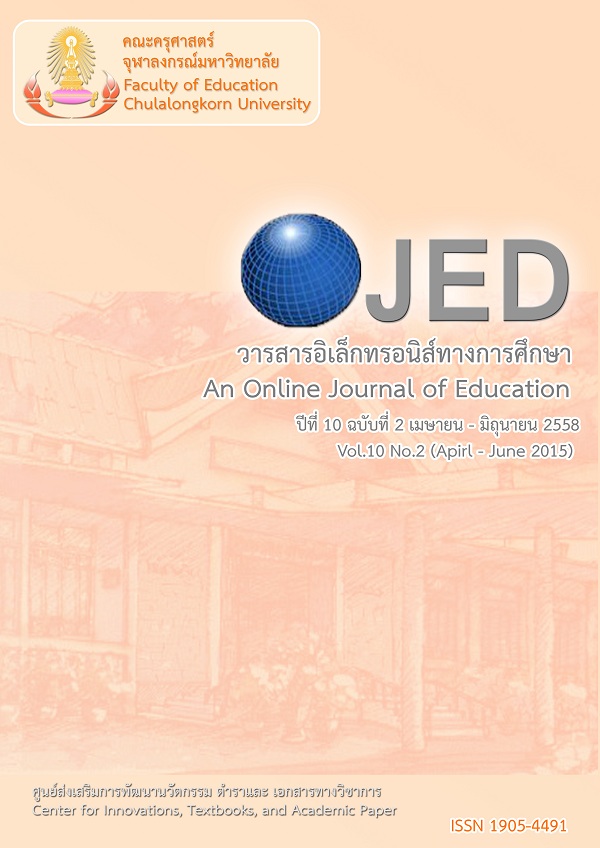ผลของการใช้รูปแบบการเรียนการสอนวิทยาศาสตร์ตามแนวคิดของพิซซินีร่วมกับแนวคิดการเรียนรู้แบบร่วมมือที่มีต่อความสามารถในการแก้ปัญหาและปฏิสัมพันธ์ทางสังคมของนักเรียนมัธยมศึกษาตอนต้น
Keywords:
รูปแบบการเรียนการสอนวิทยาศาสตร์ตามแนวคิดของพิซซินี, แนวคิดการเรียนรู้แบบร่วมมือ, ความสามารถในการแก้ปัญหา, ปฏิสัมพันธ์ทางสังคม, SCIENCE INSTRUCTIONAL MODEL BASED ON PIZZINI APPROACH, COOPERATIVE LEARNING APPROACH, PROBLEM SOLVING ABILITY, SOCIAL INTERACTIOAbstract
การวิจัยครั้งนี้เป็นการวิจัยกึ่งทดลอง มีวัตถุประสงค์เพื่อ (1) เปรียบเทียบความสามารถในการแก้ปัญหาก่อนและหลังเรียนของนักเรียนกลุ่มที่เรียนด้วยรูปแบบการเรียนการสอนวิทยาศาสตร์ตามแนวคิดของพิซซินีร่วมกับเทคนิคการเรียน รู้แบบร่วมมือ (2) เปรียบเทียบความสามารถในการแก้ปัญหาของนักเรียนระหว่างกลุ่มที่เรียนด้วยรูปแบบการเรียนการสอนวิทยาศาสตร์ตามแนวคิดของพิซซินีร่วมกับเทคนิคการเรียนรู้แบบร่วมมือและกลุ่มที่เรียนด้วยวิธีการเรียนการสอนแบบทั่วไป (3) ศึกษาปฏิสัมพันธ์ทางสังคมของนักเรียนกลุ่มที่เรียนด้วยรูปแบบการเรียนการสอนวิทยาศาสตร์ตามแนวคิดของพิซซินีร่วมกับเทคนิคการเรียนรู้แบบร่วมมือ (4) เปรียบเทียบปฏิสัมพันธ์ทางสังคมเรียนของนักเรียนระหว่างกลุ่มที่เรียนวิทยาศาสตร์ด้วยรูปแบบการเรียนการสอนตามแนวคิดของพิซซินีร่วมกับเทคนิคการเรียนรู้แบบร่วมมือกับกลุ่มที่เรียนด้วยวิธีการเรียนการสอนแบบทั่วไป กลุ่มตัวอย่างคือ นักเรียนชั้นมัธยมศึกษาปีที่ 2 โรงเรียนสุราษฎร์พิทยา จังหวัดสุราษฎร์ธานี จานวน 2 ห้องเรียน เครื่องมือที่ใช้ในการวิจัยครั้งนี้คือ แบบวัดความสามารถในการแก้ปัญหาและแบบสังเกตพฤติกรรม ปฏิสัมพันธ์ทางสังคม วิเคราะห์ข้อมูลด้วยสถิติค่าเฉลี่ยเลขคณิต ค่าเฉลี่ยร้อยละ ส่วนเบี่ยงเบนมาตรฐาน และสถิติทดสอบที
ผลการวิจัยสรุปได้ดังนี้ (1) นักเรียนกลุ่มทดลองมีคะแนนเฉลี่ยความสามารถในการแก้ปัญหาหลังเรียนสูงกว่าก่อนเรียนอย่างมีนัยสาคัญทางสถิติที่ระดับ .05 (2) นักเรียนกลุ่มทดลองมีคะแนนเฉลี่ยความสามารถในการแก้ปัญหาสูงกว่ากลุ่มควบคุมอย่างมีนัยสาคัญทางสถิติที่ระดับ .05 (3) นักเรียนกลุ่มทดลองมีคะแนนเฉลี่ยปฏิสัมพันธ์ทางสังคมสูงกว่าเกณฑ์กาหนดไว้ (4) นักเรียนกลุ่มทดลองมีคะแนนเฉลี่ยปฏิสัมพันธ์ทางสังคมสูงกว่านักเรียนกลุ่มควบคุมอย่างมีนัยสาคัญที่ระดับ .05
This study was a quasi-experimental research. The purposes of the study were (1) to compare the problem solving ability of students between before and after learning science through the instructional model based on pizzini approach with cooperative learning approach, (2) to compare the problem solving ability of students between an experimental group and a control group, (3) to study the social interaction of students learning science through the instructional model based on pizzini approach with cooperative learning approach, and (4) to compare the social interaction of students between an experimental group and a control group. The samples were two classes of Mathayom Suksa 2 at Suratpittaya school in Suratthani province. The research instruments were the problem solving ability test and social interaction behavior observation form. The collected data was analyzed by arithmetic mean, mean of percentage, standard deviation and t-test.
After the experimental, it was found that (1) The experimental group had mean scores of problem solving ability higher than before learning at a .05 level of significance. (2) The experimental group had mean scores of problem solving ability higher than the control group at a .05 level of significance. (3) The experimental group had mean scores of social interaction which was higher than criterion score set higher than criterion score set. (4) The experimental group had mean score of social interaction higher than the control group at a .05 level of significance.




